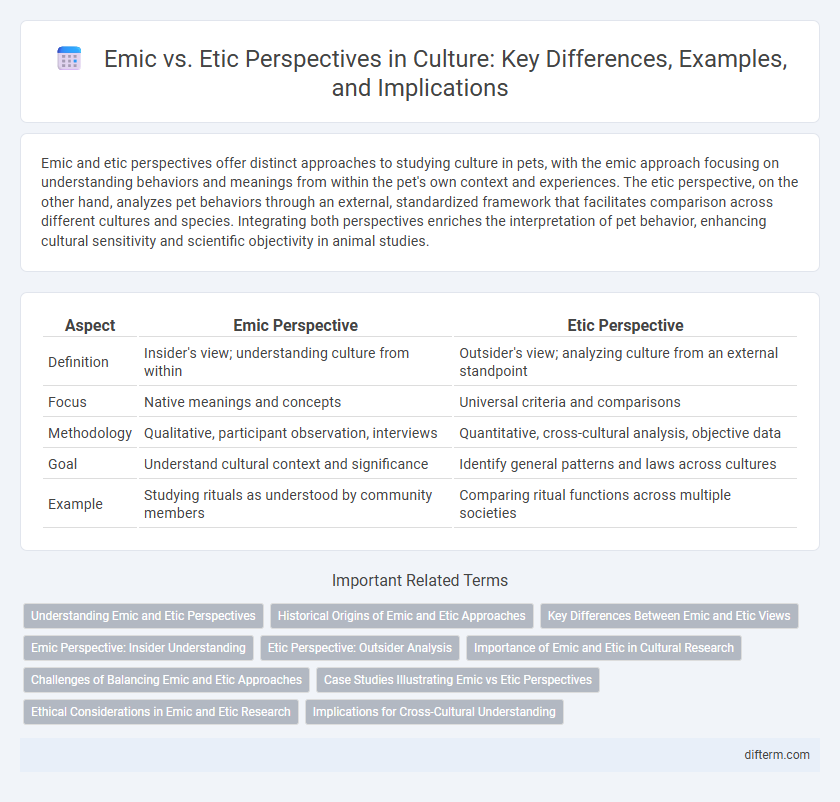Emic and etic perspectives offer distinct approaches to studying culture in pets, with the emic approach focusing on understanding behaviors and meanings from within the pet's own context and experiences. The etic perspective, on the other hand, analyzes pet behaviors through an external, standardized framework that facilitates comparison across different cultures and species. Integrating both perspectives enriches the interpretation of pet behavior, enhancing cultural sensitivity and scientific objectivity in animal studies.
Table of Comparison
| Aspect | Emic Perspective | Etic Perspective |
|---|---|---|
| Definition | Insider's view; understanding culture from within | Outsider's view; analyzing culture from an external standpoint |
| Focus | Native meanings and concepts | Universal criteria and comparisons |
| Methodology | Qualitative, participant observation, interviews | Quantitative, cross-cultural analysis, objective data |
| Goal | Understand cultural context and significance | Identify general patterns and laws across cultures |
| Example | Studying rituals as understood by community members | Comparing ritual functions across multiple societies |
Understanding Emic and Etic Perspectives
Emic perspectives emphasize understanding culture from within by exploring native speakers' beliefs, values, and meanings, providing deep insight into insider experiences and social practices. Etic perspectives analyze cultures from an outsider's viewpoint, using universal categories and comparative frameworks to identify cross-cultural patterns and differences. Combining emic and etic approaches enhances anthropological research by balancing subjective cultural nuances with objective analysis.
Historical Origins of Emic and Etic Approaches
The emic perspective, rooted in the work of linguist Kenneth Pike in the 1950s, emphasizes understanding cultural phenomena from within the social group, focusing on insiders' viewpoints and meanings. The etic approach, influenced by anthropologists like Alfred Kroeber and Clyde Kluckhohn, adopts an outsider's analytical framework to compare cultures objectively across different contexts. These approaches originated from the need to balance subjective cultural interpretations with scientific analysis in ethnographic research.
Key Differences Between Emic and Etic Views
The emic perspective analyzes culture from within, emphasizing insider viewpoints, meanings, and experiences specific to a particular group, while the etic perspective examines culture from an external, comparative standpoint using universal categories and frameworks. Emic approaches prioritize subjective, context-dependent data, capturing the richness of cultural nuances, whereas etic methods seek objective, cross-cultural generalizations. Understanding these key differences enhances cultural interpretation and anthropological research by balancing both detailed cultural insights and broader analytical consistency.
Emic Perspective: Insider Understanding
The emic perspective in cultural studies emphasizes understanding behaviors and beliefs from within the cultural context, prioritizing insider knowledge and subjective experiences. It enables researchers to capture the meanings and values attributed by community members themselves, fostering a deep cultural empathy. Emic approaches often contrast with etic methods by focusing on native categories and concepts, enhancing the authenticity of cultural interpretation.
Etic Perspective: Outsider Analysis
The etic perspective in cultural studies involves analyzing societies from an outsider's viewpoint, applying universal categories and frameworks to compare and understand diverse cultural phenomena. This approach enables researchers to identify cross-cultural patterns and generalize findings beyond specific contexts. Emphasizing objectivity, the etic perspective utilizes standardized methodologies to minimize bias and enhance replicability in cultural research.
Importance of Emic and Etic in Cultural Research
Emic and etic perspectives are crucial for comprehensive cultural research as they provide insider and outsider viewpoints, respectively, enriching understanding of cultural practices. Emic approaches prioritize the meanings and values intrinsic to the culture, revealing nuanced local interpretations that may be overlooked by external observers. Etic methods contribute objective comparisons and universal frameworks, enabling researchers to identify patterns and differences across diverse cultures.
Challenges of Balancing Emic and Etic Approaches
Balancing emic and etic approaches challenges researchers to respect cultural insiders' perspectives while maintaining analytical objectivity. Emic insights offer deep contextual understanding but may lack generalizability, whereas etic frameworks enable cross-cultural comparisons at the risk of oversimplification. Successfully integrating these viewpoints requires nuanced methodology to avoid cultural bias and ensure valid, comprehensive cultural interpretations.
Case Studies Illustrating Emic vs Etic Perspectives
Case studies illustrating emic versus etic perspectives reveal how researchers interpret cultural phenomena differently based on insider versus outsider viewpoints. For example, Margaret Mead's study of Samoan adolescence emphasized the emic perspective by highlighting local conceptions of youth and social norms, contrasting with etic analyses that apply universal psychological theories. Another case involves the interpretation of ritual practices in Balinese culture, where an emic approach uncovers culturally specific meanings, while etic interpretations focus on broader anthropological frameworks.
Ethical Considerations in Emic and Etic Research
Emic research emphasizes understanding cultural practices from the insider's viewpoint, requiring researchers to prioritize informed consent and respect for participants' values to avoid misrepresentation or harm. Etic research analyzes cultures from an outsider's perspective, demanding ethical vigilance to prevent cultural bias and ensure interpretations do not perpetuate stereotypes. Both approaches must uphold confidentiality, accurate representation, and sensitivity to cultural norms to maintain integrity and trust in anthropological studies.
Implications for Cross-Cultural Understanding
Emic perspectives provide deep insights into cultural practices by emphasizing insider views and native meanings, essential for authentic interpretation. Etic perspectives enable comparative analysis by applying external frameworks and objective criteria across cultures, facilitating broader generalizations. Balancing emic and etic approaches improves cross-cultural understanding by promoting empathy while maintaining analytical clarity.
Emic vs Etic perspectives Infographic

 difterm.com
difterm.com